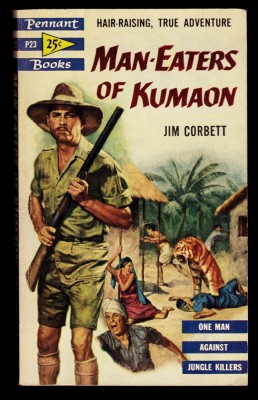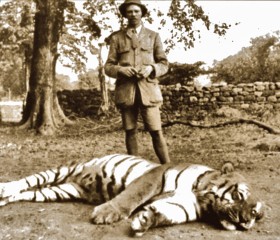When I was a boy my father brought me a paperback book he wanted to share. Dad had bought it new in 1944 and he had read and reread it until it was in shreds. So many times that it was tattered and torn, the pages were bent or loose, and the cover was detached from the spine.
The image on the cover was a movie poster style illustration of a Great White Hunter, in bush khakis, with a woman cowering behind him, as he readied his gun. Behind him, hovering over a fallen Indian villager, was a snarling tiger.
The title was “Man-Eaters of Kumaon”.
I was being given entrée into a private pleasure, and insight into another world that seemed far away, but one that would change my life forever.
.
Jim Corbett with the Bachelor of Powalgarh
Like my Dad, Jim Corbett had grown up in the woods, in his case the jungles of northern India, the son of a British officer. Between 1875 and 1955 he became an expert marksman, an accomplished woodsman and hunter, and an avid proponent of conservation in the jungles at the base of the Himalaya.
He became India’s go-to man when there was a rogue cat that had turned to killing people.
 There was always a reason for the turning to such easy prey as humans. Injury or illness prevented the cats from taking their normal prey of deer and wild pigs. Humans were an easy but poor substitute for cats under duress. In rural India, a tiger or a leopard might kill 200 people before it could be stopped. It was a desperate situation for everyone, and for Corbett, the grueling process of hunting, stalking, and killing a man-eater was a coup-de-gras, one done with great respect for the cats and their situation.
There was always a reason for the turning to such easy prey as humans. Injury or illness prevented the cats from taking their normal prey of deer and wild pigs. Humans were an easy but poor substitute for cats under duress. In rural India, a tiger or a leopard might kill 200 people before it could be stopped. It was a desperate situation for everyone, and for Corbett, the grueling process of hunting, stalking, and killing a man-eater was a coup-de-gras, one done with great respect for the cats and their situation.
His books were based on his real life stories and they read like a Hollywood script. The cats had him bested in every way with their superior sight and smell and hearing. At night they were most in their element. Corbett, as a lone man with a rifle, might as well have been under water.
All he had was a bullet and his wits. And great courage.
The cats demonstrated again and again a capacity for reason and problem solving that rivaled any adversary. The tigers regularly out-smarted his complex and elaborate traps, taking the bait without a scratch, avoiding every subterfuge. At every turn, Corbett was tested in strength and endurance. The tigers could remain unseen for days, as he waited day and night, sometimes without food, and once with an abcessed tooth that could have sent infection to his brain. Corbett’s devotion was exceeded only by the breadth and depth of these tigers’ great spirit.
Although compromised, the tigers’ dignity remained absolute as they carried themselves as the lords of their kingdom. No one would doubt their supremacy in their world.
For me, inside this threadbare thriller was a true testimony to Spirit.
Tigers carry an enormous amount of energy. Loving, devoted, and caring parents, they also fulfill a valuable role as predators at the top of the food chain. They require large tracts of land to roam and hunt and establish territory, holding energetic space for vast tracts of wilderness. They embody grace, power, and strength, and are carriers of immense light.
Even as a boy, I recognized their depth, and that there is more to these great cats than we first imagine. As the years went by, I developed a deeper understanding of the role they would play in my life. I would be visited by mountain lions in the wild on several occasions. And once, as a boy, I played with a cougar cub in a suburban back yard. As a young man, I became a Biologist and Conservationist, working for the Forestry and Wildlife Divisions of the Missouri Department of Conservation.
Jim Corbett devoted the last years of his life to protecting tigers and their habitat in India. His respect of the nobility of tigers and leopards revealed something of his own light. Many of the Indians who knew him considered him a Sadhu, or holy man. Today he is honored with the Jim Corbett National Park in northern India, at the base of the Himalaya where he came to love everything wild.
. . . . .
Attached is a video that speaks to the story of the great cats, and their place in the world.
Anna Breytenbach opens the door of communication between herself, the Caretakers at a Great Cat rescue center in Holland, and a black panther known as Diablo.
“When Diablo became Spirit” presents the turning that reveals Spirit no longer as the menacing and mistreated cat he first appears, but as the noble being that he truly is, and the change he brings to the people who care for him. Spirit’s beauty is undeniable and positively stunning.
And his compassionate message is timely and deeply moving.
As the world changes around them, the great cats find themselves seemingly out of context and in a precarious position.
I hope this story touches your heart as Jim Corbett’s compassion has touched mine.
In Love and Light,
Námasté




